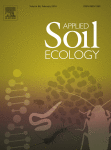Ver ítem
- xmlui.general.dspace_homeCentros Regionales y EEAsCentro Regional Buenos Aires SurEEA BalcarceArtículos científicosxmlui.ArtifactBrowser.ItemViewer.trail
- Inicio
- Centros Regionales y EEAs
- Centro Regional Buenos Aires Sur
- EEA Balcarce
- Artículos científicos
- Ver ítem
Can soil properties and agricultural land use affect arbuscular mycorrhizal fungal communities indigenous from the Argentinean Pampas soils?
Resumen
In order to determine if intensive agricultural land use and/or edaphic characteristics modify the community of the arbuscular mycorrhizal fungi (AMF) indigenous of soils from the Argentinean Pampa; mycorrhizal colonization, sporulation, glomalin (GRSP) and genetic diversity were assessed. Soils were collected from seven localities from Buenos Aires Province (Argentina) under contrasting land use intensity (at each site both pristine and agricultural
[ver mas...]
In order to determine if intensive agricultural land use and/or edaphic characteristics modify the community of the arbuscular mycorrhizal fungi (AMF) indigenous of soils from the Argentinean Pampa; mycorrhizal colonization, sporulation, glomalin (GRSP) and genetic diversity were assessed. Soils were collected from seven localities from Buenos Aires Province (Argentina) under contrasting land use intensity (at each site both pristine and agricultural soils). The capacity for root colonization, sporulation and glomalin content of trap plants and growth substrate were considered as measure of AMF activity. Analysis of diversity was conducted using PCR-single strand conformation polymorphism (SSCP). Profiles were generated by using primers to amplify the 28S rDNA of AMF from rDNA extracted directly from the substrate of trap plant or AMF spore. Five bands of the SSCP gel were sequenced and showed similarity with the genus Glomus. Analysis of colonization and GRSP content, were not clearly related to the land use intensity but sporulation capacity was, in general, lower in agricultural soils than in pristine ones. Soil phosphorus, ferrum and zinc contents, were negatively related to the root colonization and sporulation capacities. High genetic diversity was found both from soil and spore samples. Although similar diversity was found under agricultural and pristine soils, in most sites SSCP-diversity was separately clustered by land use. Still remains clarify if soil characteristics, resulting from agricultural management; exert selection pressure on the AMF and whether they could be vectors of interest to select potential plant growth promoting microorganisms.
[Cerrar]

Fuente
Applied Soil Ecology 101 : 47-56 (May 2016)
Fecha
2016-05
Editorial
Elsevier
ISSN
0929-1393
Formato
pdf
Tipo de documento
artículo
Palabras Claves
Derechos de acceso
Restringido
 Excepto donde se diga explicitamente, este item se publica bajo la siguiente descripción: Creative Commons Attribution-NonCommercial-ShareAlike 2.5 Unported (CC BY-NC-SA 2.5)
Excepto donde se diga explicitamente, este item se publica bajo la siguiente descripción: Creative Commons Attribution-NonCommercial-ShareAlike 2.5 Unported (CC BY-NC-SA 2.5)

